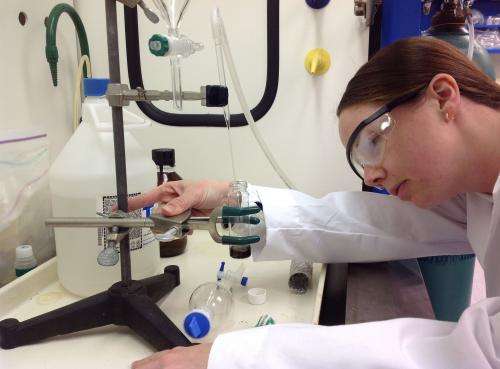Wastewater lagoons are potential energy source, researchers say

(Phys.org) —Wastewater treatment lagoons have the potential to serve as a local energy source, according to a Clarkson University doctoral student.
Stefanie Kring, an environmental science and engineering Ph.D. student, has discovered the potential biofuel content of microbes that live in local waste water treatment lagoons. Kring regularly visited the Canton, N.Y., aerated wastewater treatment lagoons during a summer research project.
She found the sunlit 8.5 acre lagoons full of planktonic (free-floating) organisms. "These were the same types of organisms that we would normally see in any lake, river or pond nearby, except that here the biomass was much, much higher," said Biology Professor Michael Twiss, who served as Kring's doctoral thesis supervisor.
Although the biofuel amount from these aerated wastewater lagoons is relatively small, these systems are found across the landscapes in New York and elsewhere in the nation. "At present, these lagoons are designed solely for wastewater treatment, but if the design could be modified to also serve the purpose of greater biofuel production then we may have found a productive path to satisfying some local needs for useful energy such as biodiesel," said Professor Susan Powers, the Spence Professor in Sustainable Environmental Systems at Clarkson University and co-investigator in this project.
Kring's analysis showed that the amount of algae was far lower than would be expected based on the high level of nutrients that were present. "How could this be and where were the algae going?" she asked.
The answer lay in the numbers of zooplankton living in the lagoons. Zooplankton are shrimp-like crustaceans that feed primarily on algae in the water column. Normally, they are the middle step in an aquatic food chain that goes from algae to zooplankton to fish. "The lagoons contain some bottom-feeding fish, but they do not seem to be impacting the zooplankton population," said Kring. This lack of predation allows zooplankton to proliferate, and exist in higher than average concentrations.
This is an important finding because one of the biggest difficulties with using algae to make biofuels like biodiesel is getting the oil out of the algae. The zooplankton can help. "These zooplankton grow fast, they select algae from among all of the other particles present in the water, they break apart the algae in their digestive tracts and they preferentially accumulate the oil in their structures and eggs. Collecting zooplankton from water is much easier than collecting microscopic algae, due to their larger size," said Kring. "Therefore, it will be less energy intensive to remove larger zooplankton from the water column, rather than microscopic algae."
The results of this research were recently published in the journal Environmental Technology.
Provided by Clarkson University



















